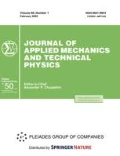Abstract
The analytical perturbation method is applied here to solve the problem of radiative heat transfer between a gas and solid particles. The data obtained are compared with results calculated by the numerical Runge-Kutta method.
Similar content being viewed by others
References
S. Abbasbandy, “The application of homotopy analysis method to nonlinear equations arising in heat transfer,” Phys. Lett., A360, 109–113 (2006).
S. J. Liao and I. Pop, “Explicit analytic solution for similarity boundary layer equations,” Int. J. Heat Mass Transfer, 47, 75–85 (2004).
D. D. Ganji and M. Rafei, “Solitary wave solutions for generalized Hitora-Satsuma coupled KdV equation by homotopy perturbation method,” Phys. Lett., A356, 131–137 (2006).
A. Aziz and G. Hamad, “Regular perturbation expansions in heat transfer,” Int. J. Mech. Eng. Educ., 5, 167 (1997).
S. J. Liao, “Boundary element method for general nonlinear differential operators,” Eng Anal. Bound. Elem., 202, 91–99 (1997).
S. V. Iyer and K. Vafai, “Passive heat transfer augmentation in a cylindrical annulus utilizing multiple perturbations on the inner and outer cylinders,” Numer. Heat Transfer, A6, 567–586 (1999).
T. K. Aldoss, Y. D. Ali, M. A. Al-Nimr, “MHD mixed convection from a horizontal circular cylinder,” Numer. Heat Transfer, A4, 379–396 (1996).
J. H. He, “Non-perturbative methods for strongly nonlinear problems,” Dissertation de-Verlag im Internet GmbH, Berlin (2006).
D. D. Ganji and A. Rajabi, “Assessment of homotopy perturbation and perturbation methods in heat transfer radiation equations,” Int. Commun. Heat Mass Transfer, 33, 391–400 (2006).
M. R. Siddique and R. E. Khayat, “Transient linear and nonlinear heat conduction in weakly modulated domains,” Numer. Heat Transfer, A5, 481–500 (2003).
J. F. Branco, C. T. Pinho, and R. A. Figueiredo, “A dimensionless analysis of radial heat conduction with variable external convection boundary conditions,” Int. Commun. Heat Mass Transfer, 28, No. 4, 489–497 (2001).
J. D. Cole, Perturbation Methods in Applied Mathematics, Blaisdell Publ. Co., Waltham (1968).
A. H. Nayfeh, Perturbation Methods, John Wiley and Sons, New York (2000).
R. Bellman, Perturbation Techniques in Mathematics, Physics and Engineering, Holt, Rinehart and Winston, New York (1964).
A. H. Nayfeh, Perturbation Methods, John Wiley and Sons, New York (1973).
M. Van Dyke, Perturbation Methods in Fluid Mechanics, Parabolic Press, Stanford (1975).
S. Goroshin, M. Bidabadi, and J. H. S. Lee, “Quenching distance of laminar flame in aluminium dust clouds,” Combust Flame, 105, 147–160 (1996).
Author information
Authors and Affiliations
Corresponding author
Additional information
__________
Translated from Prikladnaya Mekhanika i Tekhnicheskaya Fizika, Vol. 50, No. 6, pp. 55–60, November–December, 2009.
Rights and permissions
About this article
Cite this article
Shahrbabaki, A.S., Abazari, R. Perturbation method for heat exchange between a gas and solid particles. J Appl Mech Tech Phy 50, 959–964 (2009). https://doi.org/10.1007/s10808-009-0129-4
Received:
Published:
Issue Date:
DOI: https://doi.org/10.1007/s10808-009-0129-4




